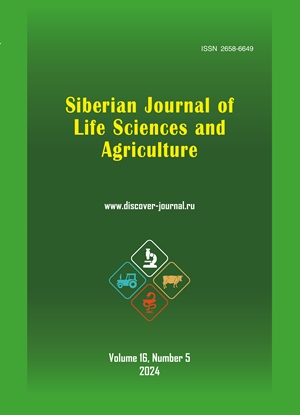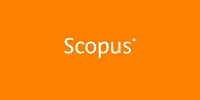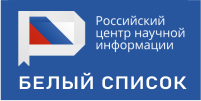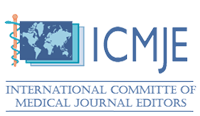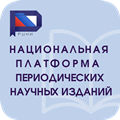РАЗРАБОТКА НАБОРОВ ДЛЯ ИДЕНТИФИКАЦИИ БАКТЕРИЙ РОДА CLOSTRIDIUM И ТОКСИНОТИПОВ CL. PERFRINGENS
Аннотация
Клостридиоз крупного рогатого скота является одной из важнейших проблем ветеринарной медицины, животноводства и безопасности пищевых продуктов. Возбудители клостридиоза вызывают инфекционные заболевания, относящиеся к зооантропонозным. Клостридии присутствуют в желудочно-кишечном тракте и в виде спор в тканях здоровых животных и могут вызывать заболевания при температурном или производственном стрессе, минеральном дисбалансе, травмах и нарушении иммунного ответа. Клостридии образуют высокоустойчивые споры, которые могут сохраняться в окружающей среде в течение длительного периода времени.
Целью нашей работы являлась разработка новых и оптимизация существующих ПЦР тест-систем для диагностики бактерий рода Clostridium и токсинотипов Cl. perfringens. Актуальность разработок тест-систем связана с отсутствием коммерческих наборов для диагностики многих видов клостридий, что затрудняет постановку правильного диагноза и подбора рациональной терапии и вакцинопрофилактики.
Материалы и методы. Разработанные и оптимизированные тест-системы для диагностики клостридиозов основаны на методах ПЦР в реальном времени и классической ПЦР.
В данной статье представлены результаты разработок тест-систем для быстрой и недорогой диагностики значимых для животноводства клостридиальных инфекций. Впервые были созданы тест-системы для детекции Cl. sordellii, Cl. novyi (типы А, B) методом классической ПЦР и Cl. histolyticum в режиме реального времени и оптимизированы ПЦР тест-системы для обнаружения Cl. chauvoei, Cl. septicum в режиме реального времени, Cl. tetani, Cl. botulinum методом классической ПЦР и мультиплексная тест-система для типизации изолятов Cl. perfringens (A-E).
Информация о финансировании. Исследование проведено в рамках проекта № 23-26-00053 «Разработка тест-систем для молекулярно-генетической диагностики клостридий с идентификацией токсинотипов и генов антибиотикорезистентности» при финансовой поддержке Российского научного фонда.
Скачивания
Литература
Список литературы
Безбородова Н.А., Соколова О.В., Кожуховская В.B., Томских О.Г., Печура Е.В., Суздальцева М.А. Патогенные виды клостридий и их устойчивость к антибиотикам, факторы вирулентности и геномные особенности // Инновации и продовольственная безопасность. 2023. Т. 3. С. 39-51. https://doi.org/10.31677/2311-0651-2023-41-3-39-51
Глотова Т.И., Терентьева Т.Е., Глотов А.Г. Возбудители и возрастная восприимчивость крупного рогатого скота к клостридиозам // Сибирский вестник сельскохозяйственной науки. 2017. Т. 47. № 1. С. 90-96.
Данилюк А.В., Капустин А.В. Распространенность и видовое разнообразие клостридий – возбудителей анаэробных инфекций крупного рогатого скота // Труды Всероссийского НИИ экспериментальной ветеринарии им. Я.Р. Коваленко. 2019. Т. 81. С. 19-26. https://doi.org/10.30917/ATT-PRINT-2019-10
Predicting DNA duplex stability from the base sequence / K. J. Breslauer, R. Frank, H. Blöcker, L. A. Marky // Proceedings of the National Academy of Sciences of the United States of America, 1986, vol. 83, no. 11, pp. 3746-3750. https://doi.org/10.1073/pnas.83.11.3746
Defining the roles of TcdA and TcdB in localized gastrointestinal disease, systemic organ damage, and the host response during Clostridium difficile infections / G. P. Carter, A. Chakravorty, T. A. Pham Nguyen, S. Mileto, F. Schreiber, L. Li, P. Howarth, S. Clare, B. Cunningham, S. P. Sambol, A. Cheknis, I. Figueroa, S. Johnson, D. Gerding, J. I. Rood, G. Dougan, T. D. Lawley, D. Lyras // mBio, 2015, vol. 6, no. 3, art. e00551. https://doi.org/10.1128/mBio.00551-15
Chandrasekaran R., Lacy D. B. The role of toxins in Clostridium difficile infection // FEMS microbiology reviews, 2017, vol. 41, no. 6, pp. 723–750. https://doi.org/10.1093/femsre/fux048
Prevention of the main Clostridial diseases in cattle / R. Compiani, S. Grossi, L. Lucini, C.A. Sgoifo Rossi // Large Animal Review, 2021, vol. 27, no. 1, pp. 51-56.
Primer-BLAST: a tool to design target-specific primers for polymerase chain reaction / J. Ye, G. Coulouris, I. Zaretskaya, I. Cutcutache, S. Rozen, T. L. Madden // BMC bioinformatics, 2012, vol. 13, art. 134. https://doi.org/10.1186/1471-2105-13-134
Revisiting the evolution and taxonomy of Clostridia, a phylogenomic update / P. Cruz-Morales, C. A. Orellana, G. Moutafis, G. Moonen, G. Rincon, L. K. Nielsen, E. Marcellin // Genome biology and evolution, 2019, vol. 11, no. 7, pp. 2035-2044. https://doi.org/10.1093/gbe/evz096
Edwards A. N., Suárez J. M., McBride S. M. Culturing and maintaining Clostridium difficile in an anaerobic environment // Journal of visualized experiments: JoVE, 2013, no. 79, art. e50787. https://doi.org/10.3791/50787
Popoff M. R., Brüggemann H. Regulatory networks controlling neurotoxin synthesis in Clostridium botulinum and Clostridium tetani // Toxins, 2022, vol. 14, no. 6, art. 364. https://doi.org/10.3390/toxins14060364
The utilization of a commercial soil nucleic acid extraction kit and PCR for the detection of Clostridium tetanus and Clostridium chauvoei on farms after flooding in Taiwan / S. W. Huang, J. P. Chan, W. Y. Shia, C. L. Shyu, K. C. Tung, C. Y. Wang // The Journal of veterinary medical science, 2013, vol. 75, no. 4, pp. 489-495. https://doi.org/10.1292/jvms.12-0271
Lange M., Neubauer H., Seyboldt C. Development and validation of a multiplex real-time PCR for detection of Clostridium chauvoei and Clostridium septicum // Molecular and cellular probes, 2010, vol. 24, no. 4, pp. 204-210. https://doi.org/10.1016/j.mcp.2010.03.003
NetF-producing Clostridium perfringens and its associated diseases in dogs and foals / I. Mehdizadeh Gohari, S. Unterer, A. E. Whitehead, J. F. Prescott // Journal of veterinary diagnostic investigation, 2020, vol. 32, no. 2, pp. 230-238. https://doi.org/10.1177/1040638720904714
Unipro UGENE: a unified bioinformatics toolkit / K. Okonechnikov, O. Golosova, M. Fursov, UGENE team // Bioinformatics (Oxford, England), 2012, vol. 28, no. 8, pp. 1166-1167. https://doi.org/10.1093/bioinformatics/bts091
Popoff M. R., Brüggemann H. Regulatory networks controlling neurotoxin synthesis in Clostridium botulinum and Clostridium tetani // Toxins, 2022, vol. 14, no. 6, art. 364. https://doi.org/10.3390/toxins14060364
Expansion of the Clostridium perfringens toxin-based typing scheme / J. I. Rood, V. Adams, J. Lacey, D. Lyras, B. A. McClane, S. B. Melville, R. J. Moore, M. R. Popoff, M. R. Sarker, J. G. Songer, F. A. Uzal, F. Van Immerseel // Anaerobe, 2018, vol. 53, pp. 5-10. https://doi.org/10.1016/j.anaerobe.2018.04.011
Primer3Plus, an enhanced web interface to Primer3 / A. Untergasser, H. Nijveen, X. Rao, T. Bisseling, R. Geurts, J. A. Leunissen // Nucleic acids research, 2007, vol. 35(Web Server issue), pp. W71-W74. https://doi.org/10.1093/nar/gkm306
Towards an understanding of the role of Clostridium perfringens toxins in human and animal disease / F. A. Uzal, J. C. Freedman, A. Shrestha, J. R. Theoret, J. Garcia, M. M. Awad, V. Adams, R. J. Moore, J. I. Rood, B. A. McClane // Future microbiology, 2014, vol. 9, no. 3, pp. 361–377. https://doi.org/10.2217/fmb.13.168
Clostridial diseases of horses: a review / F. A. Uzal, M. A. Navarro, J. Asin, E. E. Henderson // Vaccines, 2022, vol. 10, no. 2, art. 318. https://doi.org/10.3390/vaccines10020318
Weese J. S. Clostridium (Clostridioides) difficile in animals // Journal of veterinary diagnostic investigation, 2020, vol. 32, no. 2, pp. 213–221. https://doi.org/10.1177/1040638719899081
Vaccine production to protect animals against pathogenic Clostridia / N. E. Zaragoza, C. A. Orellana, G. A. Moonen, G. Moutafis, E. Marcellin // Toxins, 2019, vol. 11, no 9, art. 525. https://doi.org/10.3390/toxins11090525
References
Bezborodova N. A, Sokolova O. V., Kozhukhovskaya V. B., Tomskikh O. G., Pechura E. V., Suzdal'tseva M. A. Patogennye vidy klostridiy i ikh ustoychivost' k antibiotikam, faktory virulentnosti i genomnye osobennosti [Pathogenic species of clostridia and their antibiotic resistance, virulence factors, and genomic feature].
Innovacii i prodovolʹstvennaâ bezopasnostʹ, 2023, vol. 3, pp. 39-51. https://doi.org/10.31677/2311-0651-2023-41-3-39-51
Glotova T. I., Terent'eva T. E., Glotov A. G. Vozbuditeli i vozrastnaya vospriimchivost' krupnogo rogatogo skota k klostridiozam [Pathogens and age susceptibility of cattle to Clostridiosis]. Sibirskij vestnik selʹskohozâjstvennoj nauki, 2017, vol. 47, no. 1, pp 90-96.
Danilyuk A. V., Kapustin A. V. Rasprostranennost' i vidovoe raznoobrazie klostridiy – vozbuditeley anaerobnykh infektsiy krupnogo rogatogo skota [The prevalence and species diversity of clostridia, the causative agents of anaerobic infections in cattle]. Trudy Vserossiyskogo NII eksperimental'noy veterinarii im. Ya.R. Kovalenko, 2019, vol. 81, pp. 19-26. https://doi.org/10.30917/ATT-PRINT-2019-10
Breslauer K. J., Frank R., Blöcker H., Marky L. A. Predicting DNA duplex stability from the base sequence. Proceedings of the National Academy of Sciences of the United States of America, 1986, vol. 83, no. 11, pp. 3746-3750. https://doi.org/10.1073/pnas.83.11.3746
Carter G. P., Chakravorty A., Pham Nguyen T. A., Mileto S., Schreiber F., Li L., Howarth P., Clare S., Cunningham B., Sambol S. P., Cheknis A., Figueroa I., Johnson S., Gerding D., Rood J. I., Dougan G., Lawley T. D., Lyras D. Defining the roles of TcdA and TcdB in localized gastrointestinal disease, systemic organ damage, and the host response during Clostridium difficile infections. mBio, 2015, vol. 6, no. 3, art. e00551. https://doi.org/10.1128/mBio.00551-15
Chandrasekaran R., Lacy D. B. The role of toxins in Clostridium difficile infection. FEMS microbiology reviews, 2017, vol. 41, no 6, pp. 723–750. https://doi.org/10.1093/femsre/fux048
Compiani R., Grossi S., Lucini L., Sgoifo Rossi C.A. Prevention of the main Clostridial diseases in cattle. Large Animal Review, 2021, vol. 27, no. 1, pp. 51-56.
Ye J., Coulouris G., Zaretskaya I., Cutcutache I., Rozen S., Madden T. L. Primer-BLAST: a tool to design target-specific primers for polymerase chain reaction. BMC bioinformatics, 2012, vol. 13, art. 134. https://doi.org/10.1186/1471-2105-13-134
Cruz-Morales P., Orellana C. A., Moutafis G., Moonen G., Rincon G., Nielsen L. K., Marcellin E. Revisiting the evolution and taxonomy of Clostridia, a phylogenomic update. Genome biology and evolution, 2019, vol. 11, no. 7, pp. 2035-2044. https://doi.org/10.1093/gbe/evz096
Edwards A. N., Suárez J. M., McBride S. M. Culturing and maintaining Clostridium difficile in an anaerobic environment. Journal of visualized experiments: JoVE, 2013, no. 79, art. e50787. https://doi.org/10.3791/50787
Popoff M. R., Brüggemann H. Regulatory networks controlling neurotoxin synthesis in Clostridium botulinum and Clostridium tetani. Toxins, 2022, vol. 14, no. 6, art. 364. https://doi.org/10.3390/toxins14060364
Huang S. W., Chan J. P., Shia W. Y., Shyu C. L., Tung K. C., Wang C. Y. The utilization of a commercial soil nucleic acid extraction kit and PCR for the detection of Clostridium tetanus and Clostridium chauvoei on farms after flooding in Taiwan. The Journal of veterinary medical science, 2013, vol. 75, no. 4, pp. 489-495. https://doi.org/10.1292/jvms.12-0271
Lange M., Neubauer H., Seyboldt C. Development and validation of a multiplex real-time PCR for detection of Clostridium chauvoei and Clostridium septicum. Molecular and cellular probes, 2010, vol. 24, no. 4, pp. 204-210. https://doi.org/10.1016/j.mcp.2010.03.003
Mehdizadeh Gohari I., Unterer S., Whitehead A. E., Prescott J. F. NetF-producing Clostridium perfringens and its associated diseases in dogs and foals. Journal of veterinary diagnostic investigation, 2020, vol. 32, no. 2, pp. 230-238. https://doi.org/10.1177/1040638720904714
Okonechnikov K., Golosova O., Fursov M., UGENE team. Unipro UGENE: a unified bioinformatics toolkit. Bioinformatics (Oxford, England), 2012, vol. 28, no. 8, pp. 1166-1167. https://doi.org/10.1093/bioinformatics/bts091
Popoff M. R., Brüggemann H. Regulatory networks controlling neurotoxin synthesis in Clostridium botulinum and Clostridium tetani // Toxins, 2022, vol. 14, no. 6, art. 364. https://doi.org/10.3390/toxins14060364
Rood J. I., Adams V., Lacey J., Lyras D., McClane B. A., Melville S. B., Moore R. J., Popoff M. R., Sarker M. R.,. Songer J. G, Uzal F. A., Van Immerseel F. Expansion of the Clostridium perfringens toxin-based typing scheme. Anaerobe, 2018, vol. 53, pp. 5-10. https://doi.org/10.1016/j.anaerobe.2018.04.011
Untergasser A., Nijveen H., Rao X., Bisseling T., Geurts R., Leunissen J. A. Primer3Plus, an enhanced web interface to Primer3. Nucleic acids research, 2007, vol. 35(Web Server issue), pp. W71-W74. https://doi.org/10.1093/nar/gkm306
Uzal F. A., Freedman J. C., Shrestha A., Theoret J. R., Garcia J., Awad M. M., Adams V., Moore R. J., Rood J. I., McClane B. A. Towards an understanding of the role of Clostridium perfringens toxins in human and animal disease. Future microbiology, 2014, vol. 9, no. 3, pp. 361–377. https://doi.org/10.2217/fmb.13.168
Uzal F. A., Navarro M. A., Asin J., Henderson E. E. Clostridial diseases of horses: a review. Vaccines, 2022, vol. 10, no. 2, art. 318. https://doi.org/10.3390/vaccines10020318
Weese J. S. Clostridium (Clostridioides) difficile in animals. Journal of veterinary diagnostic investigation, 2020, vol. 32, no. 2, pp. 213–221. https://doi.org/10.1177/1040638719899081
Zaragoza N. E., Orellana C. A., Moonen G. A., Moutafis G., Marcellin E. Vaccine production to protect animals against pathogenic Clostridia. Toxins, 2019, vol. 11, no. 9, art. 525. https://doi.org/10.3390/toxins11090525
Просмотров аннотации: 81 Загрузок PDF: 41
Copyright (c) 2024 Natalia A. Bezborodova, Nikolai A. Martynov, Evgenia N. Shilova, Vladlena D. Zubareva, Veronika V. Kozhukhovskaya, Olga V. Sokolova

Это произведение доступно по лицензии Creative Commons «Attribution-NonCommercial-NoDerivatives» («Атрибуция — Некоммерческое использование — Без производных произведений») 4.0 Всемирная.

